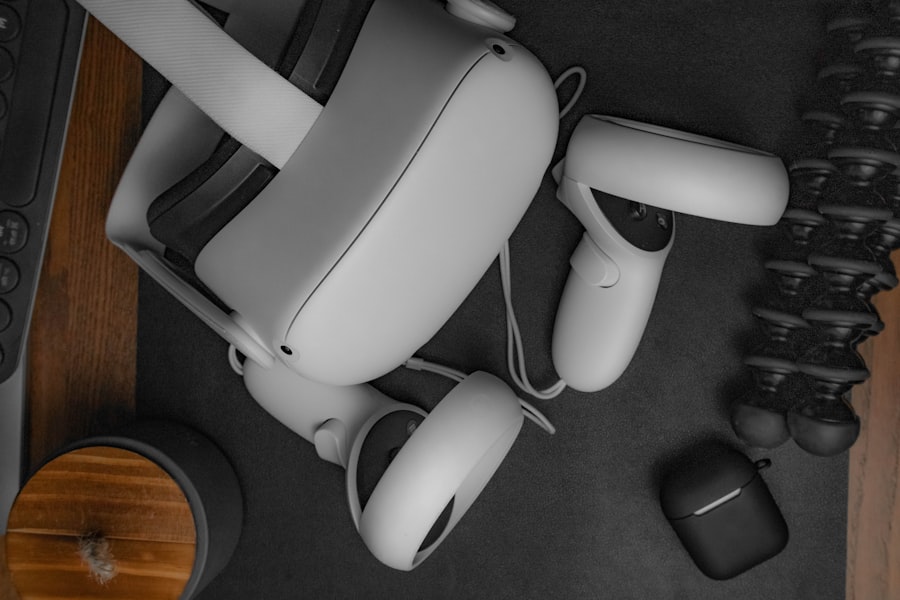The integration of virtual reality (VR) into medical education, often referred to as MedVR, has gained significant traction in recent years. This rise can be attributed to several factors, including advancements in technology, the increasing complexity of medical procedures, and the need for more effective training methods. Traditional medical education has long relied on lectures, textbooks, and hands-on practice in clinical settings.
However, these methods often fall short in providing students with the immersive experiences necessary to develop critical skills. MedVR offers a solution by creating realistic simulations that allow students to practice in a safe environment without the risks associated with real-life patient interactions. Moreover, the COVID-19 pandemic accelerated the adoption of MedVR technologies as educational institutions sought innovative ways to continue training amidst social distancing measures.
With in-person interactions limited, educators turned to virtual platforms to deliver content and engage students. This shift not only highlighted the potential of MedVR but also demonstrated its effectiveness in maintaining educational continuity. As a result, many institutions began investing in VR technologies, recognizing their potential to enhance learning outcomes and better prepare students for the challenges they will face in their medical careers.
Key Takeaways
- MedVR education is on the rise, offering immersive learning experiences in medical education.
- Virtual reality has a significant impact on medical training, providing advantages and challenges.
- Incorporating MedVR technology into the classroom enhances the learning experience for medical students.
- The future of MedVR education looks promising, with potential for further advancements and innovations.
- Ethical considerations in MedVR education are important to ensure responsible and effective implementation in medical training.
Immersive Learning Experiences in Medical Education
Enhanced Technical Skills
VR simulations can replicate surgical procedures, allowing students to practice techniques such as suturing or laparoscopic surgery without the need for cadavers or live patients. This hands-on approach fosters a deeper understanding of anatomy and procedural skills, as students can visualize and manipulate 3D models of human organs and systems.
Building Confidence and Competence
The ability to repeat these simulations as often as necessary enables learners to build confidence and competence before entering real-world clinical environments. This repetition allows students to refine their skills and make mistakes in a safe and controlled environment, reducing the risk of errors in real-life situations.
Developing Essential Soft Skills
Immersive learning experiences extend beyond technical skills; they also encompass soft skills essential for effective patient care. MedVR can simulate patient interactions, enabling students to practice communication, empathy, and decision-making in high-pressure situations. For example, a VR scenario might place a student in a virtual emergency room where they must assess a patient’s condition and communicate effectively with both the patient and their healthcare team.
The Impact of Virtual Reality on Medical Training

The impact of virtual reality on medical training is profound and multifaceted. One of the most significant benefits is the ability to provide immediate feedback to learners. In traditional settings, feedback may come after a procedure is completed or during debriefing sessions.
In contrast, VR simulations can offer real-time assessments, allowing students to understand their mistakes and correct them on the spot. This immediate reinforcement enhances learning retention and accelerates skill acquisition, making it an effective tool for mastering intricate medical procedures. Furthermore, VR training can be tailored to individual learning styles and paces.
Each student has unique strengths and weaknesses; some may excel in theoretical knowledge but struggle with practical application, while others may find hands-on tasks more intuitive. MedVR allows educators to customize training experiences based on these differences, providing personalized pathways that cater to each learner’s needs. This adaptability not only improves overall competency but also fosters a more inclusive learning environment where all students can thrive.
Advantages and Challenges of MedVR Education
| Advantages | Challenges |
|---|---|
| Enhanced engagement | Technical issues |
| Realistic simulations | Cost of equipment |
| Interactive learning | Training for educators |
| Safe environment for practice | Access to technology |
The advantages of MedVR education are numerous and compelling. One of the most notable benefits is the reduction of training costs associated with traditional methods. Medical schools often face high expenses related to cadaver procurement, maintenance of simulation labs, and clinical placements for students.
By incorporating VR technology, institutions can significantly lower these costs while still providing high-quality training experiences. Additionally, VR simulations can be accessed remotely, allowing students to practice anytime and anywhere, further enhancing accessibility. However, despite its many advantages, MedVR education also presents challenges that must be addressed.
One significant concern is the initial investment required for VR technology and infrastructure. While costs have decreased over time, acquiring high-quality VR equipment and developing comprehensive training programs can still be prohibitive for some institutions. Furthermore, there is a learning curve associated with integrating new technologies into existing curricula.
Educators must be adequately trained to utilize these tools effectively and ensure that they align with educational objectives.
Incorporating MedVR Technology into the Classroom
Incorporating MedVR technology into medical education requires careful planning and collaboration among faculty members, technology experts, and curriculum developers. A successful implementation strategy begins with identifying specific learning objectives that can be enhanced through VR experiences. For instance, if a course focuses on surgical techniques, educators can design VR modules that simulate various procedures relevant to the curriculum.
By aligning VR content with established learning goals, educators can ensure that students derive maximum benefit from these immersive experiences.
Educators must be engaged in the development process and provided with adequate training on how to use VR tools effectively.
This may involve workshops or pilot programs where faculty can experiment with VR simulations before introducing them to students.
The Future of MedVR Education

The future of MedVR education appears promising as technological advancements continue to reshape the landscape of medical training. Emerging technologies such as artificial intelligence (AI) and machine learning are poised to enhance VR simulations further by creating adaptive learning environments that respond to individual student performance in real time. For example, AI algorithms could analyze a student’s actions during a simulation and adjust the difficulty level or provide tailored feedback based on their performance history.
Furthermore, as VR technology becomes more sophisticated and affordable, its adoption is likely to expand beyond medical schools into continuing education for practicing healthcare professionals. Lifelong learning is essential in medicine due to rapid advancements in treatments and technologies; therefore, offering VR-based refresher courses or skill enhancement programs could become commonplace. This evolution would not only benefit individual practitioners but also improve overall patient care by ensuring that healthcare providers remain up-to-date with the latest techniques and best practices.
Case Studies: Successful Implementation of MedVR in Medical Education
Several institutions have successfully implemented MedVR programs that serve as models for others looking to adopt this innovative approach. One notable example is the University of Illinois College of Medicine at Chicago, which developed a comprehensive VR curriculum for surgical training. The program utilizes high-fidelity simulations that allow students to practice various surgical techniques in a risk-free environment.
Evaluations have shown that students who participated in the VR training demonstrated significantly improved performance during actual surgeries compared to those who received traditional instruction alone. Another compelling case study comes from Stanford University School of Medicine, where researchers created a VR platform designed to enhance empathy among medical students. The program immerses students in scenarios where they experience life from the perspective of patients facing chronic illnesses or disabilities.
Feedback from participants indicated that this immersive experience significantly increased their understanding of patient challenges and improved their communication skills during clinical interactions. Such initiatives highlight the diverse applications of MedVR technology in fostering both technical proficiency and empathetic patient care.
Ethical Considerations in MedVR Education
As with any emerging technology in education, ethical considerations surrounding MedVR must be carefully examined. One primary concern is the potential for desensitization among students who repeatedly engage with simulated patient scenarios that involve trauma or distressing situations. While immersive experiences can enhance empathy and understanding, there is a risk that overexposure may lead to emotional detachment or burnout among future healthcare providers.
Educators must strike a balance between providing realistic training experiences while ensuring that students remain sensitive to the emotional aspects of patient care. Additionally, issues related to data privacy and security must be addressed when implementing MedVR technologies. Many VR platforms collect user data for performance tracking and assessment purposes; therefore, institutions must establish clear policies regarding data usage and protection to safeguard student information.
Transparency about how data will be used and ensuring compliance with relevant regulations are essential steps in maintaining trust between educators and learners. In conclusion, while MedVR education presents exciting opportunities for enhancing medical training through immersive experiences and personalized learning pathways, it also necessitates careful consideration of ethical implications and challenges associated with its implementation. As this field continues to evolve, ongoing dialogue among educators, technologists, and ethicists will be crucial in shaping a responsible approach to integrating virtual reality into medical education.
FAQs
What is the purpose of the MedVR Education logo?
The purpose of the MedVR Education logo is to represent the brand and identity of the MedVR Education platform. It serves as a visual symbol that helps to distinguish and promote the platform.
What does the MedVR Education logo look like?
The specific design of the MedVR Education logo may vary, but it typically includes elements related to medical education and virtual reality. This may include symbols such as a stethoscope, medical cross, VR headset, or other related imagery.
Why is the MedVR Education logo important?
The MedVR Education logo is important because it helps to create brand recognition and awareness. It serves as a visual representation of the platform and can help to establish a sense of trust and credibility among users and stakeholders.
Where can the MedVR Education logo be found?
The MedVR Education logo can typically be found on the platform’s website, promotional materials, social media accounts, and any other official communications or marketing materials. It may also be used in partnership or sponsorship arrangements.
Can the MedVR Education logo be used by others?
The use of the MedVR Education logo by others is typically restricted to authorized partners, sponsors, or affiliates. Any use of the logo by third parties would likely require permission from MedVR Education to ensure proper usage and representation of the brand.




